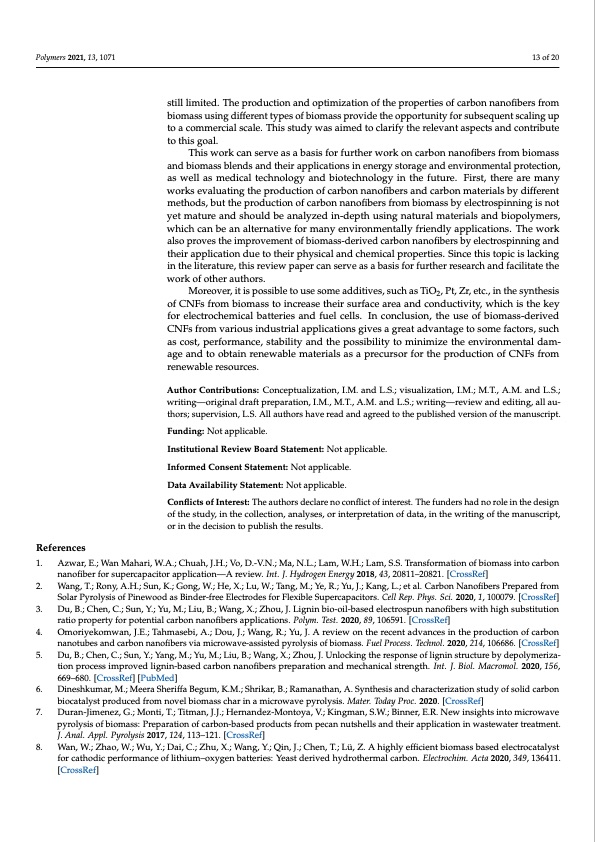
PDF Publication Title:
Text from PDF Page: 013
Polymers 2021, 13, 1071 13 of 20 References still limited. The production and optimization of the properties of carbon nanofibers from biomass using different types of biomass provide the opportunity for subsequent scaling up to a commercial scale. This study was aimed to clarify the relevant aspects and contribute to this goal. This work can serve as a basis for further work on carbon nanofibers from biomass and biomass blends and their applications in energy storage and environmental protection, as well as medical technology and biotechnology in the future. First, there are many works evaluating the production of carbon nanofibers and carbon materials by different methods, but the production of carbon nanofibers from biomass by electrospinning is not yet mature and should be analyzed in-depth using natural materials and biopolymers, which can be an alternative for many environmentally friendly applications. The work also proves the improvement of biomass-derived carbon nanofibers by electrospinning and their application due to their physical and chemical properties. Since this topic is lacking in the literature, this review paper can serve as a basis for further research and facilitate the work of other authors. Moreover, it is possible to use some additives, such as TiO2, Pt, Zr, etc., in the synthesis of CNFs from biomass to increase their surface area and conductivity, which is the key for electrochemical batteries and fuel cells. In conclusion, the use of biomass-derived CNFs from various industrial applications gives a great advantage to some factors, such as cost, performance, stability and the possibility to minimize the environmental dam- age and to obtain renewable materials as a precursor for the production of CNFs from renewable resources. Author Contributions: Conceptualization, I.M. and L.S.; visualization, I.M.; M.T., A.M. and L.S.; writing—original draft preparation, I.M., M.T., A.M. and L.S.; writing—review and editing, all au- thors; supervision, L.S. All authors have read and agreed to the published version of the manuscript. Funding: Not applicable. Institutional Review Board Statement: Not applicable. Informed Consent Statement: Not applicable. Data Availability Statement: Not applicable. Conflicts of Interest: The authors declare no conflict of interest. The funders had no role in the design of the study, in the collection, analyses, or interpretation of data, in the writing of the manuscript, or in the decision to publish the results. 1. Azwar, E.; Wan Mahari, W.A.; Chuah, J.H.; Vo, D.-V.N.; Ma, N.L.; Lam, W.H.; Lam, S.S. Transformation of biomass into carbon nanofiber for supercapacitor application—A review. Int. J. Hydrogen Energy 2018, 43, 20811–20821. [CrossRef] 2. Wang, T.; Rony, A.H.; Sun, K.; Gong, W.; He, X.; Lu, W.; Tang, M.; Ye, R.; Yu, J.; Kang, L.; et al. Carbon Nanofibers Prepared from Solar Pyrolysis of Pinewood as Binder-free Electrodes for Flexible Supercapacitors. Cell Rep. Phys. Sci. 2020, 1, 100079. [CrossRef] 3. Du, B.; Chen, C.; Sun, Y.; Yu, M.; Liu, B.; Wang, X.; Zhou, J. Lignin bio-oil-based electrospun nanofibers with high substitution ratio property for potential carbon nanofibers applications. Polym. Test. 2020, 89, 106591. [CrossRef] 4. Omoriyekomwan, J.E.; Tahmasebi, A.; Dou, J.; Wang, R.; Yu, J. A review on the recent advances in the production of carbon nanotubes and carbon nanofibers via microwave-assisted pyrolysis of biomass. Fuel Process. Technol. 2020, 214, 106686. [CrossRef] 5. Du, B.; Chen, C.; Sun, Y.; Yang, M.; Yu, M.; Liu, B.; Wang, X.; Zhou, J. Unlocking the response of lignin structure by depolymeriza- tion process improved lignin-based carbon nanofibers preparation and mechanical strength. Int. J. Biol. Macromol. 2020, 156, 669–680. [CrossRef] [PubMed] 6. Dineshkumar, M.; Meera Sheriffa Begum, K.M.; Shrikar, B.; Ramanathan, A. Synthesis and characterization study of solid carbon biocatalyst produced from novel biomass char in a microwave pyrolysis. Mater. Today Proc. 2020. [CrossRef] 7. Duran-Jimenez, G.; Monti, T.; Titman, J.J.; Hernandez-Montoya, V.; Kingman, S.W.; Binner, E.R. New insights into microwave pyrolysis of biomass: Preparation of carbon-based products from pecan nutshells and their application in wastewater treatment. J. Anal. Appl. Pyrolysis 2017, 124, 113–121. [CrossRef] 8. Wan, W.; Zhao, W.; Wu, Y.; Dai, C.; Zhu, X.; Wang, Y.; Qin, J.; Chen, T.; Lü, Z. A highly efficient biomass based electrocatalyst for cathodic performance of lithium–oxygen batteries: Yeast derived hydrothermal carbon. Electrochim. Acta 2020, 349, 136411. [CrossRef]PDF Image | Electrospun Carbon Nanofibers from Biomass and Biomass Blends

PDF Search Title:
Electrospun Carbon Nanofibers from Biomass and Biomass BlendsOriginal File Name Searched:
88145ac687f0c36c7096f236fabe2cba856c.pdfDIY PDF Search: Google It | Yahoo | Bing
Sulfur Deposition on Carbon Nanofibers using Supercritical CO2 Sulfur Deposition on Carbon Nanofibers using Supercritical CO2. Gamma sulfur also known as mother of pearl sulfur and nacreous sulfur... More Info
CO2 Organic Rankine Cycle Experimenter Platform The supercritical CO2 phase change system is both a heat pump and organic rankine cycle which can be used for those purposes and as a supercritical extractor for advanced subcritical and supercritical extraction technology. Uses include producing nanoparticles, precious metal CO2 extraction, lithium battery recycling, and other applications... More Info
| CONTACT TEL: 608-238-6001 Email: greg@infinityturbine.com | RSS | AMP |